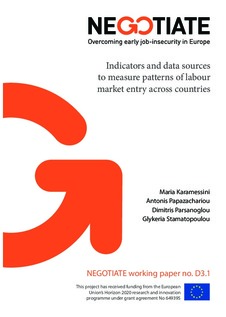| dc.contributor.author | Karamessini, Maria | |
| dc.contributor.author | Papazachariou, Antonis | |
| dc.contributor.author | Parsanoglou, Dimitris | |
| dc.contributor.author | Stamatopoulou, Glykeria | |
| dc.date.accessioned | 2017-06-22T08:16:28Z | |
| dc.date.accessioned | 2020-08-27T21:02:05Z | |
| dc.date.accessioned | 2021-04-30T07:34:23Z | |
| dc.date.available | 2017-06-22T08:16:28Z | |
| dc.date.available | 2020-08-27T21:02:05Z | |
| dc.date.available | 2021-04-30T07:34:23Z | |
| dc.date.issued | 2015-09-29 | |
| dc.identifier.uri | https://hdl.handle.net/20.500.12199/942 | |
| dc.description.abstract | Job insecurity has been gaining research and policy attention throughout the two last decades.
However, its definition and conceptualisation remain open questions within the relevant literature. When it comes to measuring early job insecurity and patterns of school-to-work transition, several methodological approaches have been proposed. Methods and variables largely depend on existing data sources. National databases have been developed in a significantly uneven way hindering comparability between different countries. Despite the existence of internationally comparable datasets that cover the EU and EEA countries, these datasets are characterised by specific limitations and constraints that render the detection of comparable transition patterns a difficult yet extremely challenging task. | |
| dc.description.sponsorship | Early job insecurity in Europe: Mapping diversity and the impact of the economic crisis - NEGOTIATE WP3 | |
| dc.language.iso | en | |
| dc.relation | info:eu-repo/649395/EC/H2020/649395/ | |
| dc.relation.ispartofseries | NEGOTIATE Working Paper;3.1 | |
| dc.subject | Negotiation | |
| dc.subject | Job insecurity | |
| dc.subject | Europe | |
| dc.subject | Labour markets | |
| dc.title | Indicators and data sources to measure patterns of labour market entry across Europe | |
| dc.type | Working paper | |
